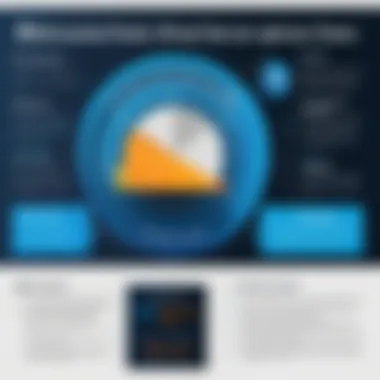Understanding Jscape MFT Server Pricing Strategies


Intro
Navigating the world of Managed File Transfer (MFT) solutions can be complex, especially when it comes to pricing. Jscape MFT Server is a prominent player in this realm, offering a range of features designed to streamline secure file transfer. Understanding the pricing strategies of Jscape is essential for organizations planning to invest in secure file transfer solutions. This article will delve deeply into the various pricing models Jscape employs, factors that influence these costs, and how they compare with other offerings in the market.
Overview of Software
Purpose and Use Cases
Jscape MFT Server is engineered primarily for secure file transfer and management. It is suitable for various industries, including finance, healthcare, and technology, where data security is paramount. Organizations employ Jscape to automate file transfer processes, ensure compliance with regulatory requirements, and enable secure collaboration across departments and partners.
Some common use cases include:
- Automated file transfers: Schedule and execute tasks without manual intervention.
- Remote access: Employees can securely access files from different locations.
- Data integration: Useful for transferring files between different systems and platforms.
Key Features
Jscape MFT Server is packed with features that cater to diverse needs. Here are some of the notable ones:
- Multi-protocol support: Jscape supports FTP, SFTP, FTPS, and others, allowing flexibility in file transfer methods.
- Robust security: Implements encryption, access controls, and secure token support.
- Monitoring and reporting: Offers extensive logging, alerts, and reporting tools to track activities and ensure compliance.
In-Depth Review
Performance Analysis
Evaluation of Jscape MFT Server's performance reveals its ability to handle large files and high volumes of data traffic efficiently. Users report rapid transfer speeds and minimal downtime, which are vital for mission-critical operations. Performance can vary based on network conditions; however, optimization tools are available to enhance speed further.
User Interface and Experience
The user interface of Jscape MFT Server has been designed with user-friendliness in mind. While it may seem complex at first glance, most users find that they can navigate the system with relative ease after some practice. The dashboard provides an overview of file transfer activities and system health, making it easy to monitor operations.
Overall, Jscape MFT Server remarkably balances functionality and usability, catering to both technical users and less powered personnel.
"A well-structured pricing model not only aids transparency but also fosters trust with clients."
In summary, Jscape MFT Server offers a range of useful functions which are well backed by a sensible pricing strategy. The need for secure and efficient file transfer solutions places Jscape in an advantageous position within the industry, appealing to businesses looking for robust solutions.
Preamble to Jscape MFT Server
Understanding Jscape MFT Server is essential when navigating the complex landscape of secure file transfer solutions. This section introduces the platform, laying the groundwork for deeper discussions about its pricing strategies. Knowing what Jscape MFT Server offers helps potential users assess whether the software aligns with their needs, budget, and organizational goals.
Managed File Transfer (MFT) is not just a buzzword but a critical need for businesses today. Relying on traditional methods like email or FTP can lead to security breaches and compliance issues. Jscape MFT Server seeks to address these challenges through a robust framework designed for data security, compliance, and efficiency.
The benefits of using Jscape MFT Server include enhanced security protocols, streamlined file transfer processes, and support for a variety of transfer protocols. These aspects make it a favored choice for companies that prioritize data integrity and security.
As we explore more about the server, considerations about its key features and functional enhancements become critical. This understanding will aid in informed decision-making, particularly in assessing pricing structures that fit an organization’s operational demands and financial constraints.
Overview of Managed File Transfer
Managed File Transfer (MFT) refers to a specialized software solution designed to facilitate the secure and efficient exchange of files between systems and users. MFT addresses common challenges associated with file transfers, such as data security, compliance with regulations, and operational inefficiency. Unlike traditional methods where files are sent through unsecured channels, MFT provides multiple layers of security, ensuring that sensitive information is protected throughout the transfer process.
MFT solutions typically include essential features such as encryption, user access controls, audit logs, and integration capabilities with existing systems. This tight-knit security framework aids organizations in adhering to regulatory requirements like GDPR or HIPAA, thus ensuring that they avoid potential penalties linked to data breaches.


Key Features of Jscape MFT Server
Jscape MFT Server is built on a foundation of essential features that cater to a wide range of business needs. Understanding these features helps clarify why organizations are willing to invest in this technology.
- Multi-Protocol Support: Jscape offers support for various transfer protocols, including FTP, SFTP, FTPS, and HTTP/S. This versatility allows businesses to choose the protocol that best meets their security and operational requirements.
- Strong Security Measures: Encryption, both during transit and at rest, ensures that data remains secure at all times. Additionally, compliance features facilitate adherence to various legal and regulatory frameworks.
- User Management: The software allows administrators to efficiently manage user access, permissions, and activity monitoring. This granular control prevents unauthorized access and maintains transparency in file transfer activities.
- Automation Capabilities: Automation features streamline workflows, enabling organizations to schedule and manage file transfers without manual intervention.
In summary, understanding the key features of Jscape MFT Server not only highlights its strengths but also prepares users for discussions regarding its pricing structures. Investing in a solution like this can yield both immediate and long-term benefits in secure file transfers.
Understanding Pricing Structures
Understanding pricing structures is fundamental for any organization considering the adoption of Jscape MFT Server. The costs associated with software licensing can significantly impact budgeting and long-term financial planning. A clear grasp of the pricing models available allows businesses to align their financial strategies with their operational needs. This section will explore these essential structures, focusing on different pricing models, their implications, and how they can guide informed decision-making.
Core Pricing Models
In the realm of Managed File Transfer solutions, Jscape offers various pricing models. Each model presents distinct advantages depending on the organization's requirements. The predominant core pricing structures include:
- Perpetual Licensing: This model allows users to pay a one-time fee for the software, granting indefinite usage rights. This can be financially advantageous for companies aiming for long-term use.
- Subscription-based Licensing: This option offers flexibility, allowing users to pay recurring fees for access to the software. This may include regular updates and support, making it appealing for businesses that value ongoing enhancements.
The choice between these models can dictate cash flow and overall investment value. Organizations must assess their operational needs and expected growth while considering software longevity and update requirements.
One-Time License versus Subscription
The decision between a one-time license and a subscription model is critical. A one-time license, while possibly higher upfront cost, provides perpetual access to the software. Organizations might prefer this if they project stable use over time without frequent need for revisions. Conversely, subscription models often allow for lower initial costs, which can benefit startups or smaller organizations with limited budgets.
When operating within a rapidly changing technological landscape, subscriptions might offer more value. Users can benefit from updates and new features without extra costs. Although this may mean a continuous financial commitment, the access to new advancements ensures the software remains relevant and effective.
Factors Influencing Pricing
Several factors can influence the overall pricing a user can expect when considering Jscape MFT Server. Key influences include:
- Number of Users: Pricing often scales with the number of users. Larger organizations may see higher costs compared to smaller businesses with fewer users.
- Modules and Features: Certain additional modules enable specialized functionalities. Opting for extra features can raise the base price, reflecting a tailored solution to meet specific needs.
- Support and Maintenance Requirements: Organizations may need robust support, impacting overall costs. Maintenance agreements provide peace of mind but can add to the budget.
Understanding these factors is important to devise a realistic budget. Companies should analyze their requirements carefully to avoid overspending while ensuring adequate functionality.
Breakdown of Jscape MFT Server Pricing
Understanding the breakdown of Jscape MFT Server pricing is crucial for making informed decisions about investments in data transfer solutions. This section highlights the key cost components that organizations will encounter when considering Jscape for their file transfer needs. Each element contributes uniquely to the overall expenses associated with implementation and ongoing usage.
Being aware of these elements allows businesses to budget effectively and align their financial resources with their operational requirements. Thus, a detailed breakdown serves not only to clarify potential costs but also to provide insights into how Jscape's offerings compare within the market.
Base Licensing Costs
The base licensing cost represents the fundamental fee associated with acquiring Jscape MFT Server software. It typically includes the essential features required for an organization to initiate file transfers securely. This cost varies depending on the configuration, the scope of the usage, and the number of licenses required. Organizations must evaluate their needs carefully.
It's worth noting that the base licensing fees are structured in a way to accommodate different types of businesses, ranging from small start-ups to large enterprises. Many enterprises might choose an enterprise license for an extensive user base, while smaller firms might opt for lower tier packages.
Additional User Costs
In many cases, the base license covers a limited number of users. To expand access, businesses will incur additional user costs. This cost structure can be variable. Companies that require access for numerous team members must carefully consider these costs against their budget and requirements.
These additional charges can add a significant amount to the overall expenditure, depending on the number of licenses needed. Organizations may also explore the possibility of volume discounts if large numbers of licenses are purchased upfront.


Support and Maintenance Fees
Support and maintenance are critical components of the overall investment in Jscape MFT Server. While the initial licensing fee may cover basic support, many organizations will find value in opting for additional support packages. These packages often include more comprehensive services, such as priority support, regular updates, and access to advanced technical resources.
These ongoing fees ensure that the organization can maintain its smooth operation, receive timely updates, and have access to resources that might be necessary for troubleshooting and maintenance. Being proactive can save time and resources in the long run, making this an essential consideration when budgeting for file transfer solutions.
Cost of Additional Modules and Features
Jscape MFT Server offers various additional modules and features that enhance its functionality. While the base license provides the essentials, companies often benefit from acquiring additional capabilities. Such modules may include advanced encryption options, additional protocol support, or specific compliance features.
The pricing for these additional modules can vary widely. Organizations must assess the specific needs of their environment before making decisions about which features to add. It can sometimes be advisable to start with the basic package and then incrementally add features as the need arises.
Comparative Analysis of Pricing
In the realm of Managed File Transfer solutions, understanding how Jscape MFT Server pricing stacks up against its competitors is critical. Comparative analysis offers insights not only into the relative costs but also into the features and services included at those price points. By examining different pricing strategies, potential buyers can discern the most advantageous investment for their needs.
A thorough comparative analysis considers several essential elements:
- Feature Set: Are the features offered by Jscape comparable to those of other providers? Features like security protocols, user management, and automation capabilities often dictate the value of a solution.
- Licensing Models: Different providers may have varying models, such as subscription-based pricing versus one-time fees. Understanding these models is vital for long-term budgeting.
- Support Services: Some vendors include extensive support in their pricing, while others charge extra for premium support. This can greatly impact the total cost of ownership.
By evaluating these factors, businesses can avoid overspending on solutions that do not meet their requirements.
Comparison with Competitors
When comparing Jscape MFT Server with competitors like FileZilla, IBM Sterling, and GoAnywhere, several aspects arise. Each competitor offers unique pricing structures based on features and market positioning.
- FileZilla often uses a freemium model with basic features available at no cost. However, the advanced features come with a price, and they may lack some of the more comprehensive security options.
- IBM Sterling is known for high-end features but includes higher entry costs, which may be a barrier for smaller organizations. Its pricing reflects an enterprise focus, providing robust solutions at a premium.
- GoAnywhere provides a flexible licensing model but can add up quickly depending on the additional features a company needs. It's important to weigh these costs against what Jscape offers.
A detailed side-by-side feature table can help clarify these differences for potential customers.
Value Proposition of Jscape
Jscape's value proposition rests on several key pillars that justify its investment cost:
- Robust Security: Jscape emphasizes its security features. This is critical when dealing with sensitive data transfers, which many organizations require.
- User-Friendliness: The platform is designed to be easy to navigate. This saves time and reduces the learning curve for new users, making it ideal for various organizational levels.
- Customizable Solutions: The flexibility to tailor workflows and operations to specific business needs is often highlighted as a primary advantage. This customization sets Jscape apart from others, as it can adapt to both small businesses and large enterprises.
"The choice of MFT server impacts not just cost but also operational efficiency and security. Understanding all aspects helps in making better decisions."
In summary, while Jscape MFT Server might not always present the lowest price tag, the overall value, security, and flexibility offered can be more beneficial in the long run compared to alternatives.
User Perspectives on Pricing
User perspectives on pricing hold a critical role in any discussion around software solutions, particularly in the realm of Managed File Transfer (MFT). Users, being the primary stakeholders, often provide insights based on their experiences, needs, and expectations. Understanding these perspectives helps potential buyers evaluate not only the cost but also the value derived from the investment.
When exploring Jscape MFT Server pricing, it’s important to consider both the satisfaction and dissatisfaction that users express. These insights can inform future users about realistic expectations and the potential return on investment (ROI). Additionally, feedback from existing clients can also highlight essential features, ease of use, and the system's overall integrity, influencing the decision-making process significantly.
Client Testimonials
Client testimonials serve as a powerful tool in assessing user satisfaction and overall experience with Jscape MFT Server. Many users appreciate the software's reliability and efficiency in handling large file transfers. For instance, organizations have reported a substantial reduction in transfer times, which directly correlates with increased productivity. Testimonials often reflect how Jscape supports their unique operational needs.
Consider this quote from a satisfied client:


"Jscape MFT Server has transformed our file transfer operations, allowing us to focus on core business rather than troubleshooting transfers."
These positive endorsements highlight the effectiveness of Jscape in meeting specific user requirements and reinforce trust in their pricing model. Clients find value in both the performance and the support offered by Jscape, justifying the costs associated with its multiple licensing plans.
Common Complaints and Praise
While many clients share positive experiences, it is equally important to acknowledge common complaints. Users have occasionally experienced challenges with the initial setup, which can take time and resources away from other critical tasks. Some have noted that training is required to maximize functionality, suggesting a potential hidden cost in user hours.
On the praise side, users frequently commend the architecture of Jscape MFT Server for its adaptability. This flexibility allows organizations to customize modules according to their needs, adding further value to their investment. Feedback often highlights:
- Intuitive User Interface: Many users find the software easy to navigate.
- Comprehensive Features: The array of functionalities meets diverse transfer requirements.
- Responsive Customer Service: Quick resolution of issues has been noted as a significant benefit.
Balancing the feedback received from client testimonials against the common complaints presents a nuanced perspective on Jscape MFT Server pricing. Users express that while certain aspects may not be perfect, the overall value proposition remains strong, making it a worthwhile consideration in the landscape of secure file transfer solutions.
Implementation Costs
Understanding the implementation costs associated with Jscape MFT Server is crucial for any organization considering this solution. Implementation costs encompass several critical elements that influence the overall financial outlay when adopting the software. By thoroughly examining these costs, businesses can gain clarity on their budget requirements and potential return on investment.
Infrastructure Requirements
The infrastructure requirements for Jscape MFT Server play a pivotal role in the implementation process. This encompasses both the hardware and software needed to effectively run the MFT platform. Organizations should evaluate current IT infrastructure to determine if existing setups can support the new software.
Key considerations include:
- Server Specifications: Proper server specifications are paramount. These include CPU capabilities, RAM, and storage space tailored to your anticipated data traffic.
- Network Considerations: Reliable network configurations are essential for file transfers to ensure speed and security. Companies should assess current network bandwidth to prevent bottlenecks.
- Database Compatibility: Jscape MFT Server integrates with various databases. Assessing compatibility with existing systems can prevent future discrepancies.
Investing in adequate infrastructure results in smoother transitions and reduces the likelihood of unforeseen costs.
Migration and Integration Costs
Migration and integration costs are significant components of successful implementation. Transitioning from existing systems to Jscape MFT Server can be complex, often requiring careful planning and resources. The following aspects must be scrutinized:
Common migration challenges include:
- Data Migration: Moving sensitive information from legacy systems requires meticulous handling to maintain integrity and confidentiality. This may involve utilizing specialized tools that carry their own costs.
- System Integration: Jscape MFT Server needs to integrate with current applications, such as ERP and CRM systems. This integration can involve custom development that contributes to overall costs.
- Training and Support: Organizations must account for necessary staff training on the new system. The learning curve can cause temporary inefficiencies, thereby impacting overall operational costs.
"Investing in the right migration strategy can lead to significant long-term savings and operational improvements."
By analyzing both infrastructure and migration costs, organizations can strategically allocate resources, thus enhancing their transition to Jscape MFT Server while minimizing disruptions.
End
The conclusion in this article serves as a crucial point to synthesize the knowledge accumulated regarding Jscape MFT Server pricing. Understanding this topic is essential for making informed decisions, particularly for software developers, IT professionals, and university students focused on file transfer solutions. Pricing isn't merely a number; it encapsulates the value, support, and capabilities a product offers.
Recap of Pricing Insights
In summary, Jscape MFT Server presents various pricing models that cater to different organizational needs. The core pricing strategies may include:
- One-time licensing or subscription-based access.
- Base licensing costs with additional charges for more users or features.
- Support and maintenance fees which are pivotal for ongoing operations.
The value proposition becomes clear: the better the understanding of costs, the more informed the choice. An essential insight lies in the fact that the total expenditure goes beyond initial fees. Customers must evaluate long-term benefits and support quality to justify investments. Therefore, the insights gathered here about the cost structure can enhance decision-making.
Final Thoughts on Jscape MFT Server Pricing
In the competitive landscape of managed file transfer solutions, grasping the pricing of Jscape MFT Server proves vital. Factors influencing pricing, such as infrastructure requirements and migration expenses, are just as significant as the base rates.
"Investment in the right tools today equates to operational resilience tomorrow."
By considering all these elements, stakeholders can conclude whether Jscape aligns with their strategic IT goals.







